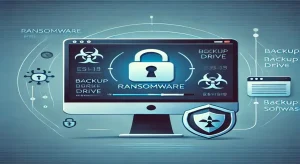- Ransomware: A Growing Cybersecurity Threat
- What is Ransomware?
- How Ransomware Spreads
- Notable Ransomware Attacks
- Detection and Prevention Strategies
- Ransomware Removal and Recovery
- Advanced Protection Strategies
- Ransomware Removal Tools: Free vs. Paid Options
- Data Protection: Neutralizing the Threat of the Worst-Case Scenario
Ransomware: A Growing Cybersecurity Threat
Ransomware has rapidly emerged as one of the most formidable cybersecurity threats, affecting both individuals and organizations worldwide. This type of malware encrypts files or locks users out of their systems, demanding a ransom to restore access. With the increasing sophistication of ransom ware attacks, understanding how this type of malware operates and taking preventive measures are crucial to safeguarding your digital assets and maintaining operational continuity.
What is Ransomware?
Ransomware is a type of malicious software specifically designed to block access to a computer system or encrypt its data until a ransom is paid. The name itself hints at its purpose: demanding a ransom for restoring access to the compromised data or systems. There are two primary types of ransom ware, each with distinct operational strategies and impacts:
- Locker Ransomware: This type of malware locks the victim out of their computer by disabling basic functions. For example, users may be denied access to their desktop, and the mouse and keyboard may only function partially, often just enough to allow interaction with the ransom demand window. While locker ransom ware does not typically target critical files, it aims to make the computer inoperable, compelling the victim to pay to regain access.
- Crypto Ransomware: Unlike locker ransom ware, crypto ransom ware focuses on encrypting valuable data, such as documents, pictures, and videos, without disrupting basic computer functions. This strategy is more insidious, as it spreads panic by allowing users to see their files but preventing access. Often, these attacks include a countdown timer, creating urgency by threatening to delete the files if the ransom isn’t paid by the specified deadline.
How Ransomware Spreads
Ransomware can infiltrate systems through various vectors, leveraging weaknesses in both technology and human behavior. Understanding these vectors is key to defending against such attacks. Here are some of the most common methods used by cybercriminals:
- Phishing Emails: Cybercriminals employ social engineering tactics to deceive victims into clicking malicious links or downloading infected attachments. These emails often mimic legitimate communications from trusted entities, making them particularly difficult to detect.
- Exploit Kits: These are automated tools that scan for vulnerabilities in software applications. Once a vulnerability is identified, the exploit kit delivers ransom ware to the victim’s system, often without their knowledge.
- Drive-By Downloads: A drive-by download occurs when a user visits a compromised website, which automatically downloads malware onto their computer without their consent or awareness. This method is particularly effective against unpatched or outdated software.
- Remote Desktop Protocol (RDP): Cybercriminals exploit weak or stolen RDP credentials to gain unauthorized access to a computer. Once inside, they can install ransom ware remotely, often without the victim realizing until it’s too late.
Notable Ransomware Attacks
Several high-profile ransom ware attacks have demonstrated the severe impact such threats can have, underscoring the importance of vigilance and preparedness:
- WannaCry (2017): Utilizing a vulnerability in Microsoft Windows, WannaCry spread rapidly across 150 countries, affecting critical services, including the UK’s National Health Service (NHS). The attack infected approximately 230,000 computers worldwide, causing an estimated $4 billion in damages.
- Locky (2016): Distributed primarily through phishing emails, Locky encrypted over 160 file types, disrupting operations across various industries. It was particularly devastating for professions relying on specific file formats, such as designers, developers, and engineers.
- Bad Rabbit (2017): This ransom ware spread via compromised websites and disguised itself as an Adobe Flash update. It mainly targeted media outlets and transportation services in Russia and Ukraine, leading to significant operational disruptions.
- Ryuk (2018): A sophisticated encryption Trojan, Ryuk targeted high-profile organizations and was known for disabling Windows recovery functions. This ransom ware caused extensive financial losses, with total damages exceeding $640,000 in some cases.
- Petya/NotPetya (2016-2017): Unlike typical ransom ware, Petya encrypted the entire hard disk by targeting the Master File Table (MFT), rendering systems completely inoperable. Its more destructive variant, NotPetya, spread globally and caused billions in damages, further highlighting the evolving nature of ransom ware threats.
Detection and Prevention Strategies
Early detection of ransom ware is crucial to mitigating its impact. Indicators of infection include unusual file extensions, increased CPU activity, and abnormal network communications. To protect against ransom ware, consider the following preventive measures:
- Regular Software Updates: Ensure your operating system and applications are up-to-date with the latest security patches to guard against known vulnerabilities that could be exploited by ransom ware.
- Avoid Suspicious Links and Attachments: Be cautious of emails from unknown senders, especially those containing links or attachments. Even familiar sources should be scrutinized for signs of phishing.
- Data Backups: Regularly back up important data to external drives or cloud storage. Ensure that backups are disconnected from the main network to prevent ransom ware from encrypting them as well.
- Install Security Software: Use reputable security software with anti-ransom ware capabilities. Enable real-time protection to detect and block ransom ware before it can cause damage.
- Network Segmentation: Divide your network into isolated segments to prevent the spread of ransom ware across the entire system. This approach limits the potential damage and aids in quicker containment.
Ransomware Removal and Recovery
If you fall victim to a ransomware attack, there are three primary recovery options:
- Pay the Ransom: Although some may consider paying the ransom, this option is generally not recommended. Paying does not guarantee data recovery and could encourage further attacks by rewarding criminal activity.
- Remove the Malware: Disconnect from the internet and use security software to identify and remove the ransom ware. A full system scan can help eliminate the threat, but the effectiveness depends on the specific type of ransom ware and its removal tool availability.
- Restore System from Backups: This is often the safest and most reliable option. Reset your computer to factory settings and restore data from backups to ensure that all traces of the ransomware are removed.
Advanced Protection Strategies
For enhanced protection against ransomware:
- Utilize Anti-Ransomware Tools: Invest in security software that offers real-time protection and is specifically designed to detect and block ransomware.
- Implement Strong Security Protocols: In corporate environments, foster a culture of cybersecurity awareness through regular training and drills. Establish response plans for potential attacks to minimize damage and ensure swift recovery.
- Adopt Cloud-Based Solutions: Cloud storage solutions often provide additional security features, such as automated backups and versioning, making data recovery simpler and more efficient.
- Regularly Update Security Software: Ensure that your security software is always updated to protect against the latest ransomware threats and other cyberattacks.
Ransomware Removal Tools: Free vs. Paid Options
Ransomware attacks are increasingly sophisticated, making it essential to have the right tools for removal and recovery. Here are some of the best options available, categorized into free and paid tools.
Free Ransomware Removal Tools
- Emsisoft Ransomware Decryption Tools
- Emsisoft offers a comprehensive suite of free decryption tools that can help victims recover encrypted files without paying the ransom. These tools are regularly updated to tackle the latest ransomware variants.
- Emsisoft Ransomware Decryption Tools
- Kaspersky NoRansom
- Kaspersky provides a wide range of free decryption tools through its NoRansom initiative. These tools support various types of ransomware and are designed to help users decrypt their data and regain access to their files.
- Kaspersky NoRansom
Paid Ransomware Removal Tools
- Malwarebytes
- Features: Malwarebytes offers advanced threat detection and removal capabilities, including protection against ransomware. It uses AI and machine learning to identify and neutralize threats in real-time.
- Pricing: Starts at $69+ per year, per endpoint.
- Malwarebytes
- Bitdefender GravityZone
- Features: This tool provides automatic ransomware remediation, real-time threat detection, and comprehensive cybersecurity protection. It includes features such as automatic backups and detailed threat analysis.
- Pricing: Starts at $42+ for the first subscription year.
- Bitdefender
- Trend Micro
- Features: Trend Micro offers robust ransomware protection along with data/file shredding, vulnerability scanning, and cyberthreat insurance. It provides hybrid/multi-cloud protection and blocks suspicious websites.
- Pricing: Starts at $40+ per year.
- Trend Micro
- ESET PROTECT
- Features: ESET offers real-time endpoint visibility and ransomware protection. It uses deep behavioral inspection and includes a ransomware shield for proactive threat defense.
- Pricing: Starts at $154+ per 5 endpoints, per year.
- ESET PROTECT
- Sophos Intercept X
- Features: Sophos provides advanced anti-ransomware technology, excellent customer support, and cyber insurance. It includes zero-trust network access, malware detection and removal, and a centralized management console.
- Pricing: Contact for a quote.
- Sophos Intercept X
Choosing the right ransomware removal tool depends on your specific needs and budget. Free tools from Emsisoft and Kaspersky are excellent for immediate decryption, while paid solutions from Malwarebytes, Bitdefender, Trend Micro, ESET, and Sophos offer comprehensive protection and advanced features for robust security. Regular updates, vigilant cybersecurity practices, and effective backup strategies are essential in mitigating the impact of ransomware attacks.
Data Protection: Neutralizing the Threat of the Worst-Case Scenario
Creating backups is essential to protect your data in case of a ransomware attack. Here are some best practices for data protection:
- Use External Hard Drives: Back up your data to external hard drives and disconnect them from your computer after each backup. This prevents this type of malware from encrypting the backup files.
- Employ Cloud Backup Services: Use reputable cloud backup services that offer automated backups and versioning. Ensure that your cloud storage provider implements strong security measures to protect your data.
- Regular Backup Schedule: Establish a regular backup schedule to ensure that your data is consistently protected. Set reminders to perform manual backups if you do not use automated services.
- Verify Backup Integrity: Periodically test your backups to ensure they can be restored.
Conclusion
Malware continues to evolve, posing significant threats to both personal and professional data security. By understanding its mechanisms, staying vigilant, and employing robust cybersecurity practices, you can protect your data and reduce the risk of falling victim to these malicious attacks.







